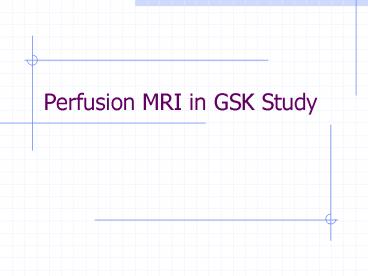Perfusion MRI in GSK Study
1 / 15
Title:
Perfusion MRI in GSK Study
Description:
Perfusion MRI in GSK Study Units Perfusion is measured in mL/100g of tissue/min, or units of CBF Normal human gray matter is perfused at a rate of 50-60mL/100g/min ... –
Number of Views:183
Avg rating:3.0/5.0
Title: Perfusion MRI in GSK Study
1
Perfusion MRI in GSK Study
2
Units
- Perfusion is measured in mL/100g of tissue/min,
or units of CBF - Normal human gray matter is perfused at a rate of
50-60mL/100g/min
3
Measurable Parameters
- CBF Cerebral Blood Flow The amount of blood
moving through a given amount of tissue per unit
time (can be absolute aCBF, or relative rCBF) - CBV Cerebral Blood Volume The amount of blood
in a given amount of tissue at any time - MTT Mean Transit Time The average amount of
time it takes any water molecule or particle of
contrast agen to pass through the voxel
vasculature
4
MRI Methods
- Bolus Tracking - use of a contrast agent such as
gadolinium as a tracer - Arterial Spin Labeling (ASL) - labels the water
molecules of blood magnetically to use as a tracer
5
Arterial Spin Labeling Method
- Tracer is a magnetic label applied to the water
molecules in the blood - Magnetic label is produced by saturating or
inverting the longitudinal component of the MR
signal - The tagged water will pass into brain tissue and
alter its longitudinal magnetization - A control image where no tagging is done is
collected after each tagged image
6
(No Transcript)
7
Calculating CBF
- DM Mcontrol Mtag
- A difference image is created from the control
and tag image that is proportional to CBF.
8
Surround Subtraction
- Perfusion images are calculated from a
combination of the control and tagged images - Odd indexed images are tagged
- Even indexed images are controls
- Perfusion weighted time series
- img1 (img0img2)/2,
(img1img3)/2-img2,
9
(No Transcript)
10
Problems with Pulsed ASL
- Slice profile effect alters the quality of the
subtraction - Measurements are sensitive to the transit time of
blood water between labeling and imaging sites
11
Solution
- Add one or more spatial saturation pulse during
the inversion time to saturate either the imaging
slice or the tagging region. This is referred to
as quantitative imaging of perfusion using a
single subtraction (QUIPSS and QUIPSSII)
12
QUIPSS RF Pulse Sequence
- Slice selective in-plane presaturation applied to
imaging slice - Inversion tag is applied
- Second saturation pulse is applied to tagging
region after a delay, TI1 (done only in QUIPSSII) - After additional delay, at time TI2, an image is
acquired using single shot EPI after the
inversion tag
13
GSK Study Basic Info
- 3 Study Days A Placebo, B Ketamine, C
KetamineLamotragine - 2 Perfusion runs 5minutes long
- One before the bolus and one after the bolus
- One Proton Density scan acquired
14
GSK Study Run Breakdown
- Localizer
- 3D T1
- T1 flash
- Fixation
- VOD
- VOD
- VOD
- Fingertap
- Proton Density
- Perfusion
- Fixation (bolus delivered)
- VOD
- VOD
- VOD
- Perfusion
15
Output Images in Analysis
- dM difference image (relative CBF)
- BOLD
- CBF (absolute CBF is calculated if Proton Density
image was specified)































